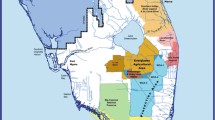Abstract
Nonpoint source (NPS) pollution has emerged as the largest threat to water quality in the United States, influencing policy makers and resource managers to direct more attention toward NPS prevention and remediation. In response, the United States Environmental Protection Agency (USEPA) spent more than $204 million in fiscal year (FY) 2006 on the Clean Water Act’s Section 319 program to combat NPS pollution, much of it on the development and implementation of watershed-based plans. State governments have also increasingly allocated financial and technical resources to collaborative watershed efforts within their own borders to fight NPS pollution. With increased collaboration among the federal government, states, and citizens to combat NPS pollution, more information is needed to understand how public resources are being used, by whom, and for what, and what policy changes might improve effectiveness. Analysis from a 50-state study suggests that, in addition to the average 35% of all Section 319 funds per state that are passed on to collaborative watershed groups, 35 states have provided financial assistance beyond Section 319 funding to support collaborative watershed initiatives. State programs frequently provide technical assistance and training, in addition to financial resources, to encourage collaborative partnerships. Such assistance is typically granted in exchange for requirements to generate a watershed action plan and/or follow a mutually agreed upon work plan to address NPS pollution. Program managers indicated a need for greater fiscal resources and flexibility to achieve water quality goals.



Similar content being viewed by others
References
Born SM and Genskow KD (2000) The Watershed Approach: An Empirical Assessment of Innovation in Environmental management. National Academy of Public Administration, Washington, DC, Research Paper Number 7
Clark BT, Burkardt N, King MD (2005) Watershed Management and Organizational Dynamics: Nationwide Findings and Regional Variation. Environmental Management 36(2):297–310
Cortner HJ, Moote MA (1999) The Politics of Ecosystem Management. Washington DC: Island Press
De Jongh P, Captain S (1999) Our common journey: A pioneering approach to Cooperative Environmental Management. London: Zed Books
Fleishman R (2004) Watershed Groups in Ohio: The Effects of Organizational Characteristics on Political Behavior, Accomplishments, and Perceived Effectiveness. Unpublished masters thesis. Columbus, OH: The Ohio State University
John D (1994) Civic Environmentalism: Alternatives to Regulation in States and Communities. Washington, DC: CQ Press
Kenney DS (1999) “Historical and Sociopolitical Context of the Western Watershed Movement”. Journal of the American Water Resources Association 35(3):493–503
Koontz TM, Thomas CW (2006) “What Do We Know and Need to Know about the Environmental Outcomes of Collaborative Management?” Public Administration Review 66(6 suppliment):109–119
Koontz TM, Steelman TJ, Carmin J, Korfmacher KS, Moseley C, Thomas CW (2004) Collaborative Environmental Management: What roles for government? Washington, D.C: Resources for the Future Press
Lant CL (1999) “Introduction: Human Dimensions of Watershed Management”. Journal of the American Water Resources Association 35(3):483–486
Leach WD, Pelkey NW (2001) Making watershed partnerships work: a review of the empirical literature. Journal of Water Resources Planning and Management 127(6):378–385
Leach WD, Pelkey NW, Sabatier PA (2002) “Stakeholder Partnerships as Collaborative Policymaking: Evaluation Criteria Applied to Watershed Management in California and Washington”. Journal of Policy Analysis and Management 21(4):645–70
Lubell M, Schneider M, Scholz JT, Mete M (2002) “Watershed Partnerships and the Emergence of Collective Action Institutions”. American Journal of Political Science 46(1):148–163
Meadowcroft J (1999) Cooperative management regimes: collaborative problem-solving to implement sustainable development. International Negotiation 4(2):225–254
Moore EA, Koontz TM (2003) “A Typology of Collaborative Watershed Groups: Citizen-based, Agency-based, and Mixed Partnerships”. Society and Natural Resources 16(5):451–460
Patton MQ (2002) Qualitative Research and Evaluation Methods (3rd edition). Sage Publications: Thousand Oaks, CA
Scheberle D (1997) Federalism and Environmental Policy: Trust and the Politics of Implementation. Georgetown University Press: Washington, DC
Sabatier PA, Focht, Will, Lubell, Mark, Trachtenberg, Zev, Vedlitz, Arnold, Marty Matlock (2005) Swimming Upstream: Collaborative Approaches to Watershed Management. The MIT Press. Cambridge, Massachusetts
Ssteelman TA, Carmin J (2002) Community Based Watershed Remediation: Connecting Organizational Resources to Social and Substantive Outcomes. In Toxic Waste and Environmental Policy in the 21st Century United States, edited by Diane Rahm. Jefferson, NC: McFarland Publishers
United States Congress. Public Law 100-4, “Water Quality Act of 1987,” Washington GOP (February 4, 1987)
USEPA (United States Environmental Protection Agency) (2007) Clean Water Act Section 319(h) Grant Funds History. http://www.epa.gov/owow/nps/319hhistory.html
USEPA (United States Environmental Protection Agency) (2003) Nonpoint Source Program and Grants Guidelines for States and Territories. EPA FR, 8/23/2003. V. 68, (205): Washington, DC
USEPA (United States Environmental Protection Agency) (2002) Section 319 Success Stories Volume III: The Successful Implementation of the Clean Water Act’s 319 Nonpoint Source Pollution Program. EPA 841-S-01-0001. Washington, DC: EPA, Office of Water
USEPA (United States Environmental Protection Agency) (2000) Stormwater Phase II Final Rule: An Overview. EPA 833-F-00-001. Washington, D.C: EPA, Office of Water
USEPA (United States Environmental Protection Agency) (1996) Why Watersheds? EPA 800-F-96-001. Washington, DC: EPA Office of Water
USEPA (United States Environmental Protection Agency) (1994) What is Nonpoint Source (NPS) Pollution? Questions and Answers. EPA 841-F-94-005. Washington, DC: EPA, Office of Water
Wondolleck JM, Yaffee SL (2000) Making Collaboration Work: Lessons from Innovation in Natural Resource Management. Washington, DC: Island Press
Acknowledgments
Funding for this research was provided by the Ohio State University School of Environment and Natural Resources and the Ohio State University Social Responsibility Initiative in the College of Food, Agricultural, and Environmental Sciences. The authors are appreciative of the participation by many federal and state personnel who shared their time and expertise.
Author information
Authors and Affiliations
Corresponding author
Rights and permissions
About this article
Cite this article
Hardy, S.D., Koontz, T.M. Reducing Nonpoint Source Pollution Through Collaboration: Policies and Programs Across the U.S. States. Environmental Management 41, 301–310 (2008). https://doi.org/10.1007/s00267-007-9038-6
Published:
Issue Date:
DOI: https://doi.org/10.1007/s00267-007-9038-6




